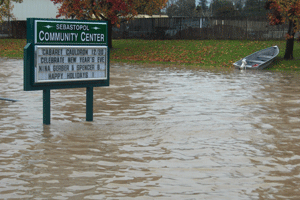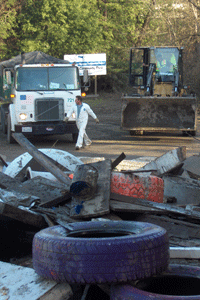Another New Year's Eve Freshet
On December 30, 2005 rain pounded northern San Francisco Bay and the coast of California throughout the day, continuing through the early hours of the following day. The storm’s intensity was accurately foretold by the National Weather Service, and loudly splashed across local newspaper headlines in advance of its arrival. By the time the rain stopped, predictions of widespread flooding along all of the region’s major waterways were fulfilled. The final measurement: five inches of rain, in just over a twenty-four hour period. Super-saturated soils on critical slopes triggered hill slides, while creeks and rivers—already swollen from the major storm of a few days prior—over-topped their banks.
By the time the sun showed itself again on New Year’s Eve, urban storm drains that weren’t able to handle the water had caused residences, businesses, and schools to flood; county bridges that crossed out-of-bank creeks were impassable; landslides closed sections of arterial highways; and sewage treatment systems, unable to handle storm-water inflow, were discharging untreated water into the system. Marin, Sonoma, Mendocino and Napa counties recorded heavy property damage and widespread interruption of services.
 Local citizens—without electricity, and shut off from their normal transportation routes by numerous closed bridges—walked to the high-water edge to gawk. The high winds of the 30th had calmed, the sun was shining through the freshly polished atmosphere: the bright sunny weather shone a spotlight on its handiwork. An unusual calm prevailed over the landscape. In every direction smooth sheets of water extended over the landscape, blanketing pastures and vineyards and hayfields in a reflecting sea—a sea that wasn’t there just a day before.
Local citizens—without electricity, and shut off from their normal transportation routes by numerous closed bridges—walked to the high-water edge to gawk. The high winds of the 30th had calmed, the sun was shining through the freshly polished atmosphere: the bright sunny weather shone a spotlight on its handiwork. An unusual calm prevailed over the landscape. In every direction smooth sheets of water extended over the landscape, blanketing pastures and vineyards and hayfields in a reflecting sea—a sea that wasn’t there just a day before.
New Year’s Eve was a somber night as the final hours of 2005 ticked away with a sense of stunned survivorship. Neighbors helped neighbors in distress, friends told their story, and public officials presided over a disrupted community unsure of what to do. A day and a night passed without rain.
The New Year dawned with overcast skies. A cold foggy drizzle settled in, replacing the sunny giddiness of the day before with an oppressive melancholy. The flood’s third day was a day to bear down and endure. The sheets of still water were transformed by the new day’s gusty outbursts into choppy, forbidding foes. Electric utility workers, unable to keep up with the magnitude of the repairs, lost ground as new outages occurred. Most people just stayed at home and coped.
January 2nd was the day that the masses returned to work—but not everyone made it. Many, still trapped in the lower Russian River corridor, remained cut off from the world. Others reeling from flood damage, dug into the task at hand. In Sebastopol, a handwritten sign on the front door of the Post Office spelled it out, “Do to weather we will be closed today.” The public library said it more simply, and with better spelling: “Closed due to weather.”
By the morning of January 3rd Russian River water that had been choked at the Forestville Narrows was running wide and strong: the retarded drainage of the Laguna de Santa Rosa was finally freed to begin flowing towards the Pacific Ocean. Bridges across the Laguna at Occidental Road and Highway 12 were reopened, with water lapping at the roadway’s edge—leaving no shoulder for pulling out—suggesting caution for drivers to keep their eyes on the road and refrain from gaping at the 360° spectacle.
Headlines and stories spanned the pages of the newspapers on the 4th and 5th outlining the extent of the flood, estimating the financial toll, recounting tales of the survivors, picturing the cleanup, and editorializing the events, trying to understand what had happened.
By January 6th, the flooded landscape was drained enough to reveal soupy, muddy fields; the waterways were flowing below flood stage; citizens were moving on with their routines; and the New Year’s Eve Flood was tallied: $100 Million in damages. The flood would go in the record books as Sonoma County’s costliest, surpassing the floods of 1986, 1995, and 1997.

